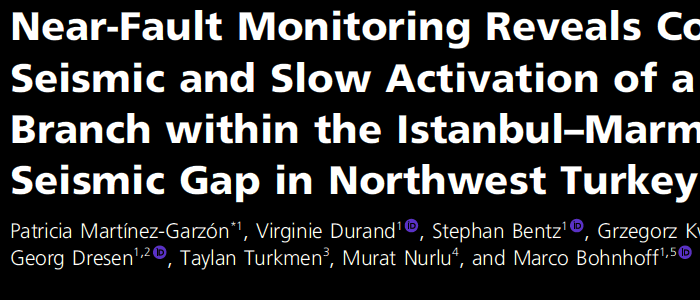Patricia Martinez-Garzon published a paper in Seismological Research Letters entitled “Near‐Fault Monitoring Reveals Combined Seismic and Slow Activation of a Fault Branch within the Istanbul–Marmara Seismic Gap in Northwest Turkey”.
Reference:
P. Martínez‐Garzón et al., ‘Near‐Fault Monitoring Reveals Combined Seismic and Slow Activation of a Fault Branch within the Istanbul–Marmara Seismic Gap in Northwest Turkey’, Seismological Research Letters, Aug. 2021, doi: 10.1785/0220210047.
Abstract:
Various geophysical observations show that seismic and aseismic slip on a fault may occur concurrently. We analyze microseismicity recordings from a temporary near‐fault seismic network and borehole strainmeter data from the eastern Marmara region in northwest Turkey to track seismic and aseismic deformation around the hypocentral region of an Mw 4.5 earthquake in 2018. A slow transient is observed that lasted about 30 days starting at the time of the Mw 4.5 event. We study about 1200 microseismic events that occurred during 417 days after the Mw 4.5 event around the mainshock fault rupture. The seismicity reveals a strong temporal clustering, including four episodic seismic sequences, each containing more than 30 events per day. Seismicity from the first two sequences displayed typical characteristics driven by aseismic slip and/or fluids, such as the activation of a broader region around the mainshock and swarm‐like topology. The third and fourth sequences correspond to typical mainshock–aftershock sequences. These observations suggest that slow slip and potentially fluid diffusion along the fault plane could have controlled the seismicity during the initial 150 days following the Mw 4.5 event. In contrast, stress redistribution and breaking of remaining asperities may have caused the activity after the initial 150 days. Our observation from a newly installed combined dense seismic and borehole strainmeter network follows an earlier observation of a slow transient occurring in conjunction with enhanced local seismic moment release in the same region. This suggests a frequent interaction of seismic and aseismic slip in the Istanbul–Marmara seismic gap.
